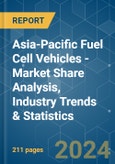The Asia-Pacific Fuel Cell Vehicles Market size is estimated at USD 1.65 billion in 2024, and is expected to reach USD 7.93 billion by 2029, growing at a CAGR of 36.89% during the forecast period (2024-2029).
Key Highlights
- Fastest-growing by country - Japan : Japan is one of the major players in the APAC FCEV electric vehicle industry due to its significant production capacity and customer demand for electric vehicles.
- Largest Segment by Country - South Korea : The adoption of e mobility and stringent norms and developments by various auto companies are fueling the growth of fuel-cell electric cars in South Korea.
- Largest Segment by Vehicle Type - Commercial Vehicles : Due to the growing demand for passenger vehicles and the scarcity of alternative electric vehicle types in the region, the passenger vehicle segment accounts for the majority of EV sales.
APAC Fuel Cell Vehicles Industry Overview
The Asia-Pacific Fuel Cell Vehicles Market is fragmented, with the top five companies occupying 16.47%. The major players in this market are Daihatsu Motor Co., Ltd., Honda Motor Company, Ltd., Hyundai Motor Company, Isuzu Motors Ltd. and Toyota Motor Corporation (sorted alphabetically).Additional Benefits:
- The market estimate (ME) sheet in Excel format
- 3 months of analyst support
Table of Contents
1 EXECUTIVE SUMMARY & KEY FINDINGS2 REPORT OFFERS7 KEY STRATEGIC QUESTIONS FOR VEHICLES CEOS
3 INTRODUCTION
4 KEY INDUSTRY TRENDS
5 MARKET SEGMENTATION
6 COMPETITIVE LANDSCAPE
8 APPENDIX
Companies Mentioned (Partial List)
A selection of companies mentioned in this report includes, but is not limited to:
- BYD Co. Ltd
- Daihatsu Motor Co., Ltd.
- Dongfeng Motor Corporation
- Ford Motor Company
- Honda Motor Company, Ltd.
- Hyundai Motor Company
- Isuzu Motors Ltd.
- Toyota Motor Corporation
Methodology

LOADING...








